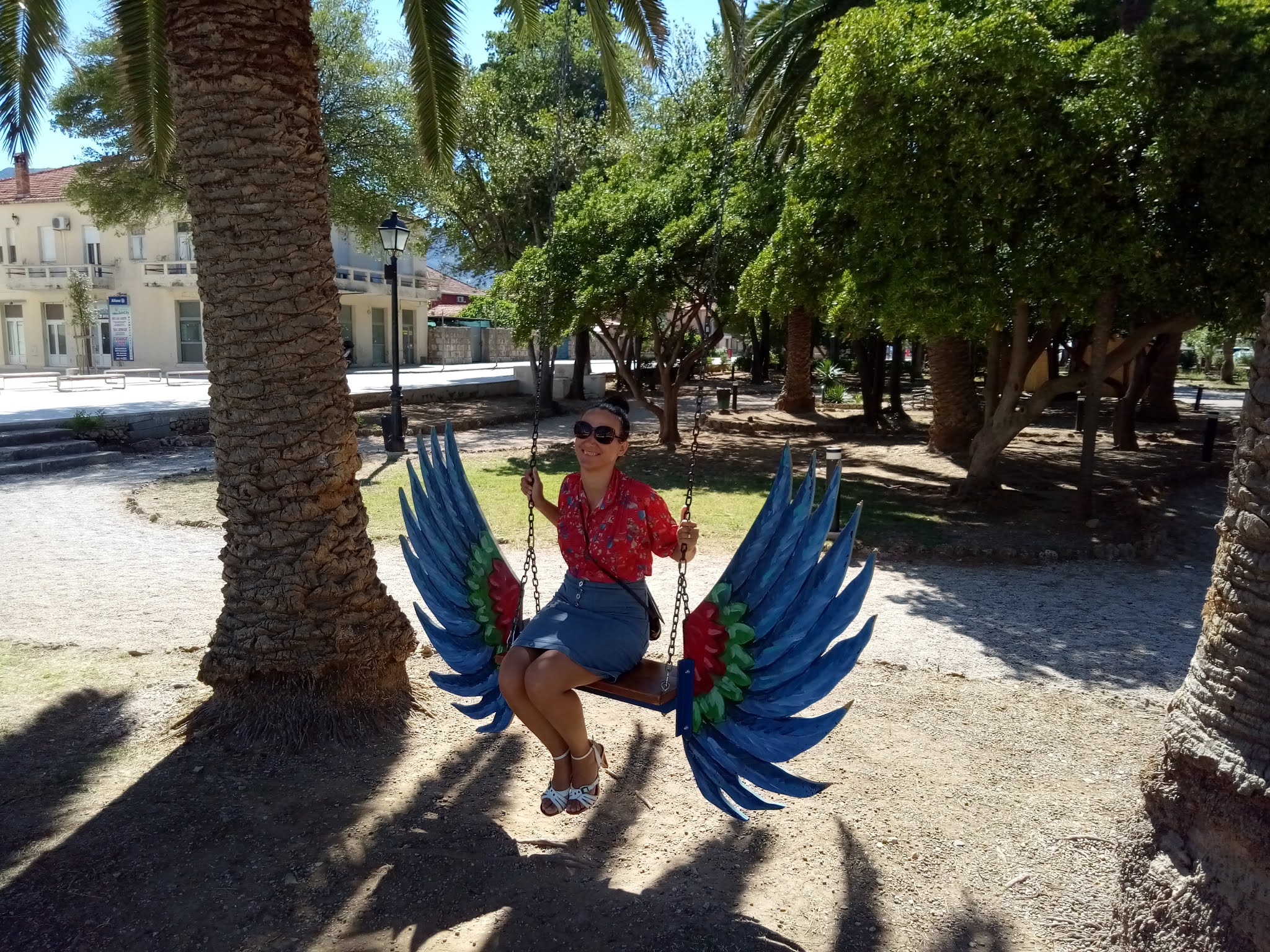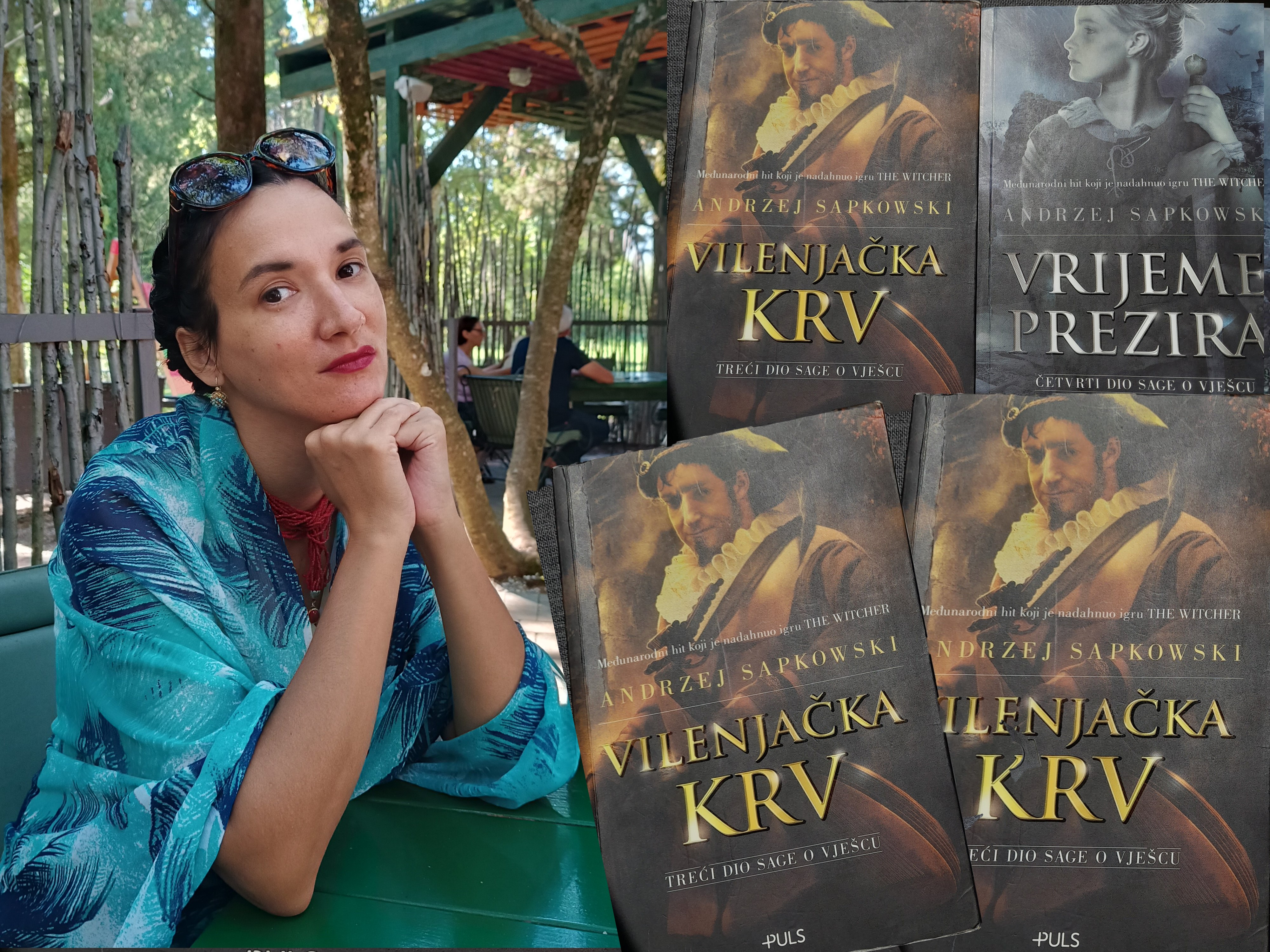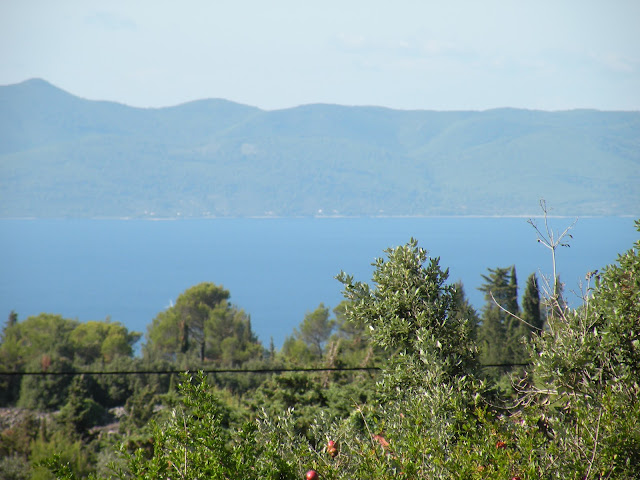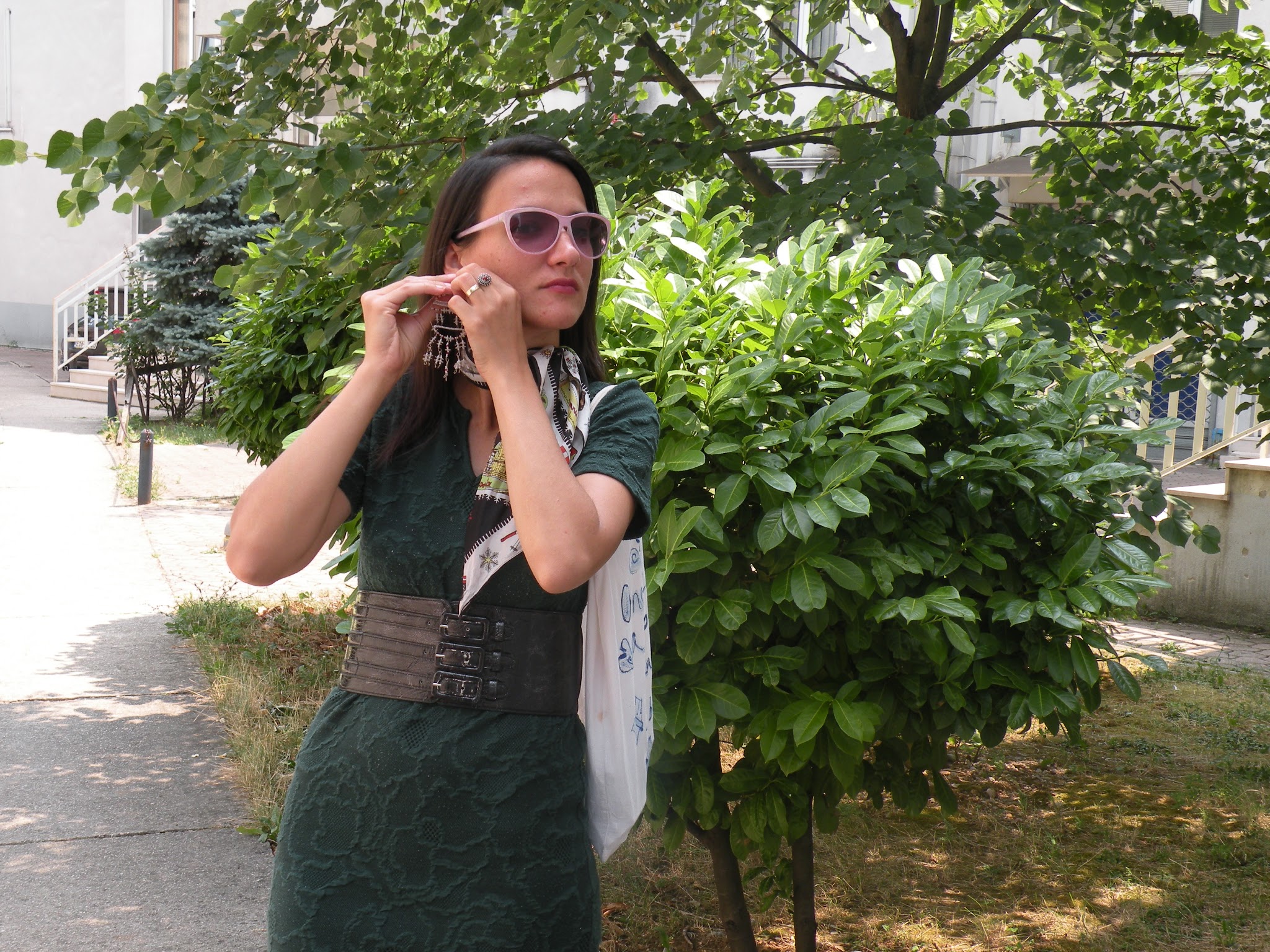BOOK REVIEW AND RECOMMENDATION: A RIVER SUTRA, A NOVEL BY GITA MEHTA
Hello there! I'm back with a book review and an outfit post. The book I will be reviewing & recommending is a novel A River Sutra by an Indian author Gita Mehta. This was my first Gita Mehta book. I will also be sharing a summer outfit with you. The location is Jelsa on island Hvar. You can actually see some of notable historical sights in the background.
HR Zdravo! Vraćam se sa ogledom knjige i odjevnom kombinacijom. Knjiga o kojoj ću pisati i koju ću preporučiti je roman Rijeka Sutra indijske autorice Gite Mehte. Ovo je prvo njezino djelo sa kojim sam se susrela. Također ću sa vama podijeliti ljetnu odjevnu kombinaciju. Lokacija je Jelsa na otoku Hvaru, a možete vidjeti i neke povijesne znamenitosti u pozadini.
A RIVER SUTRA, A NOVEL BY GITA MEHTA
A River Sutra was published in 1993 in Toronto by Randon House of Canada. The copy I have was published in 1944 by Mandarin Paperbacks. It has received much attention and is a critically acclaimed novel. Like many Anglo-Indian novels, it seems to be largely directed to the Western or in other words a foreign reader. By that I mean that the novel itself often explains things about Indian culture that are probably obvious to an Indian reader. I'm not saying that it excludes any reader or implying that the fact that is written in English makes it less authentic. I cannot be the how authentic the novel is in describing India for I'm not Indian. I can only write about my reading experience and novel as such.
WRITING STYLE AND NARRATIVE USED IN A RIVER SUTRA BY GITA MEHTA
A River Sutra is written in mid to late twentieth century style, so it is true to its time period, one could say. This novel uses a framed narrative. The narrator of the novel is an aging burocreate who decides to leave the world and retire as an in keeper. In some sense, the novel could also be called a collection of short stories. Almost every chapter in a novel is somebody's life story. All the characters in the novel including the protagonists are Indian. There are no foreign characters in the novel. The in keeper, that is the protagonist, comes in contact with both local people and travelers. The protagonist and the narrator of the novels listens to all of these stories, sometimes adding his own comments to them once they are done. However, the protagonists of these stories are narrators in their own right for it is them who tell their stories. I would say that Gita Mehta choose a good narrative technique as it enables the stories to come to life. A framed narrative is quite suitable for this work of literature and works into this novels's advantage. This novel is often about people, as the novel's opening quote from Love Songs of Chandidas implies: "Listen, O brother, Man is the greatest truth. Nothing beyond. "
THEMES THAT A RIVER SUTRA EXAMINES: RELIGION, LOVE AND LIFE
The novel opens with a paragraph: "The government still pays my wages but I no longer think of myself as a bureaucrat. Bureaucrats belong too much to the world and I have fulfilled my worldly obligations. I am now a vanaprasthi, someone who has retired to the forest to reflect." However, the protagonist doesn't exactly retire to a forest, he only assumes a different role. The protagonist goes on to explain that he has always wanted to withdrawn from the world but was aware that he is not equipped to wander the forests and survive on fruits so he chosen to apply for a vacant post at a Government rest house overlooking Narmada river. The very first page tells us something about themes that this novel examines. Religion and spiritual are very important themes in this novel. The protagonist claims that he wants to denounce the world but what does this really mean? Is the life of an aesthetic the only way to do it? Is there a correct way? The protagonist himself gets questioned on this in the course of the novel as he interacts with different characters and listens to their stories.
THE MONK'S STORY- I HAVE LOVED JUST ONE THING IN MY LIFE
In Chapter Two, our protagonists listens to The Monk's Story. The monk's story opens with following words: "I have loved just one thing in my life. You ask about the ritual with which I gained the freedom to pursue this love. Why? Ritual means nothing if you do not know the longing that precedes it." (p.13).
This Jain Monk upon the protagonist's insisting tells him his story. This follower of Jain faith came from an extremely wealthy family of diamond merchants but one day he decided to leave his family and pursue the life of a wandering beggar monk. Despite their differences, the monk's father throws him a lavishing ceremony to celebrate his monk ritual. He father does it in an effort to hide his grief, something his son comes to understand and respect. The protagonist compares his life with his own desire to withdrawn from life but struggles to understand his story. I really liked this story but it shows that nothing is easy at it seams. The followers of Jain faith seek to avoid all violence, they go so far as to carry a mask over their face at all times to avoid breathing in and accidental killing an insect. Can we really avoid suffering and violence in this world? The monk's father is a rich man who has refused to own diamond mines because they imply suffering, but his father still trades with diamonds. The monk father justifies it with the charity work he has done, saying that with his work he has done world more good than a wondering monk. Indeed, this story offers many different views on the theme of religion and spirituality. How can we do the most good in the world? As the monk in question tells his story, we learned that he was a married man with a child. Didn't his decision mean a life of suffering for his wife? It seems that nobody bothered to consult the wife of a young man. At the same time, one does feel sympathy for the young man because as we follow his life story we witness that this desire to renounce the world has followed him his all life and with time he has found it increasingly hard to suppress.
My wife was standing at the doorway listening with concern to my father's passion.
'Their ways are bleaker than you can possibly imagine. Do you know what it means to be a monk? Do you know the levels of asceticism he must suffer?'
My father was expressing himself with such urgency I dared not interrupt him. 'Do you know how that serene old monk hopes to die? Starving himself to death. He observes respect for life when all the time he is working towards the goal of denying his own life.' He stared at me waiting for my response but I could not speak. His anguish has melted the numbness that froze my heart. I was overcome by compassion for him, for myself, for my concerned and curious wife, for the human helplessness that linked us all.
It was my first experience of ahimsa.
In his attempt to frighten me my father has made me realise that to prevent suffering a man has to be capable of suffering, that a man who cannot suffer is not alive. (p.32, 33).
The monk in question seems aware of the fact that his act of becoming a wondering monk will hurt many people. To life is to suffer is the lesson that this chapter seems to imply. I liked how his story wasn't idolized and explained how even something that seems so selfless as a devoting to a spiritual path can cause a lot of suffering for a lot of people. Perhaps we cannot avoid hurting others and ourselves, no matter how much we try. This became evident to me when I read the following words:
"I can see the anguish on my father's face as he searches for me but I have become a stranger garbed in white, my facial features hidden behind a muslin mask." (p.38)
This chapter is so well written. The author is very vivid in her description of the ceremony that signified monk's renouncing of the world. The description of the streets and the crowds is almost naturalistic and provides a contrast with the spiritual struggle inside the monk's soul. What is the only thing he has loved in his life? This is the question that continues to haunt the reader as the monk announces that it is time for him to return to his brothers, for he is 'too poor to renounce the world twice.' (p.39). I was left wondering: poor in what sense? So many questions are left open.
CHAPTER THREE- TARAQ MIA AND AN INTRODUCTION TO A NEW STORY
Chapter Three opens with following words: "For some time the memory of the monk disturbs me" (p. 40). Like the protagonist, I was somewhat disturbed by the monk's story but I also loved it. What is the only thing the monk has ever loved? Was it love itself, the human capacity for love? It is only when the monk stopped accusing his father and sympathizes with him, that he understood the true meaning of compassion. Chapter Three introduces another character, an elderly teacher Taraq Mia with whom the protagonist often plays chess. Besides impressing him with his simple love for the Lord showed in his singing prayers, Taraq Mia also serves as a narrator for another story. This is the pattern that the novels follows. Many chapters are stories in their own right while other chapters are reflection on those stories. Most stories are told directly but sometimes there is another character who tells these stories, so we get a story within a story.
WHAT KIND OF NOVEL IS A RIVER SUTRA?
How to describe this novel? What it is about? I described the opening paragraphs, the protagonist, the first few chapters, the writing style and so on. I analysed one of the stories in this novel in more detail and - but what is this novel really about? I would say that is about life itself, about life, love and suffering.
The majestic river Narmada serves as a connector to all these stories. Its 'immortality' is often referenced. This is a novel about India, the modern and the old country of mystery. The author connects the ancient Indian mythologies, religions and teachings with the present beautifully. What a beautiful novel this is. It could also be described as a collection of stories for it,as I already stressed, features many different stories. The central characters is a man who has left his important job and in some sense retired. He is without a family and wants to renounce the world. However, he keeps meeting different people who tell him his life stories and this makes him realize that leaving the world may not be as easy at it seems. What it means to denounce the world? As he hears the stories of a mystic, a monk, a music teacher, a courtesans and a government official, our protagonists learns a lot but is left with perhaps even more questions than ever. As a reader I was left with many questions as well and I loved it. I actually like how this novel doesn't give you any definite answers but rather encourages you to find your own answers.
MY READING EXPERIENCE- HOW LONG IT TOOK ME TO READ THIS BOOK?
It didn't take me long to read this book, about two hours in total. I was immediately drawn into it. I set to read this book during a ferry ride and despite being distracted by a horrid group of drunken tourists I managed to finish it within two hours. It really says something about how wonderful this book is for that group of young men was insufferable. When one watches TV, you see this type of men, the loud MTV style jackass idiots, but I always assumed that those kind of people are not real. Tourism made me realize that such specimens of humans not only exists but seem to be prevalent among young in Western societies. I escaped the saloon in an effort to get from that pathetic sight, but some of them went out as well and continued being obnoxiously loud. However, this novel was so engaging and well written that it made it easier for me to ignore the outside noise. Now, that I think of it, perhaps my reading experience was appropriate and had a lesson to teach in itself. Often in my life, I have chosen to distance myself in an effort to keep a piece of mind and now I wonder has it left me a colder person. I wonder if I have lost some of my sympathy along the way. I'm an emphatic person but I don't think it's the same as sympathy and love. This novel gave me a lot of food for the thought.
MY READING EXPERIENCE- HOW LONG IT TOOK ME TO READ THIS BOOK?
It didn't take me long to read this book, about two hours in total. I was immediately drawn into it. I set to read this book during a ferry ride and despite being distracted by a horrid group of drunken tourists I managed to finish it within two hours. It really says something about how wonderful this book is for that group of young men was insufferable. When one watches TV, you see this type of men, the loud MTV style jackass idiots, but I always assumed that those kind of people are not real. Tourism made me realize that such specimens of humans not only exists but seem to be prevalent among young in Western societies. I escaped the saloon in an effort to get from that pathetic sight, but some of them went out as well and continued being obnoxiously loud. However, this novel was so engaging and well written that it made it easier for me to ignore the outside noise. Now, that I think of it, perhaps my reading experience was appropriate and had a lesson to teach in itself. Often in my life, I have chosen to distance myself in an effort to keep a piece of mind and now I wonder has it left me a colder person. I wonder if I have lost some of my sympathy along the way. I'm an emphatic person but I don't think it's the same as sympathy and love. This novel gave me a lot of food for the thought.
CONCLUSION- A RIVER SUTRA IS AN ABSOLUTE GEM OF A BOOK
This was my first novel by Gita Mehta, but I doubt it will be the least. This is a gem of a book. I do recommend it to everyone but especially to lovers of mythology and India.

WHAT TO SEE AND DO IN JELSA? HISTORICAL CHURCHES, OLD CITY CENTRE AND A HISTORICAL PARK
Jelsa is a beautiful little place. What to see in Jelsa and do in Jelsa? There are certainly quite a few beautiful and historical attractions to see here. To start, why not visit the old city (Civitas Vetus Ielsae)? The old city of Jelsa (where part of the defensive wall is also preserved) is definitely worth a visit! There are also many beautiful churches to see: the church of the Saint Mary of Health (built in 1535), the church of San Roch (built in the second half of the 16th century), the church of Saint Michael (built in 1463). In Jelsa you can also find one of the largest is the most beautiful parks in Dalmatia - Perivoj, built in 1870.
IT Jelsa è un bel posticino. Cosa vedere e fare a Jelsa? Ci sono molte belle e storiche attrazioni da vedere qui. Per iniziare, perché non visitare la città vecchia (Civitas Vetus Ielsae)? La vecchia città di Jelsa (dove è conservata anche una parte delle mura difensive) merita sicuramente una visita! Ci sono anche molte belle chiese da vedere: la chiesa di Santa Maria della Salute (costruita nel 1535), la chiesa di San Rocco (costruita nella seconda metà del XVI secolo), la chiesa di San Michele (costruita nel 1463). Inoltre, a Jelsa puoi anche trovare uno dei più grandi parchi della Dalmazia: Perivoj, costruito nel 1870.
HR Jelsa je prekrasno malo mjesto. Što vidjeti u Jelsi? Ovdje se može vidjeti puno lijepih i povijesnih atrakcija. Za početak, zašto ne posjetiti stari dio grada (Civitas Vetus Ielsae)? Stari dio mjesta Jelsa (u kojem je sačuvan i dio obrambenog zida) definitivno vrijedi posjetiti! Tu se mogu vidjeti i mnoge lijepe crkve: crkva Gospe od Zdravlja (izgrađena 1535.), crkva Svetog Roka (sagrađena u drugoj polovici 16. stoljeća), crkva Svetog Mihajla (sagrađena 1463.). Osim toga, u Jelsi možete pronaći i jedan od najvećih najljepših parkova u Dalmaciji , park Perivoj, izgrađen 1870. godine.
MY PREVIOUS POSTS ABOUT JELSA /MOJE PRIJAŠNJE OBJAVE O JELSI
For more photographs and information about Jelsa, visit my previous posts:
Isn't it fun how I found a swing that matches my outfit? As always thank you for reading and listening. Have a nice day!





















I'll have to check out this book, sounds great. I love this swing, it's so cool!! I hope you have a fantastic week :) x
ReplyDeleteI also want to check out this book and stunning photos you shared of that beautiful place.
ReplyDeleteTraditional dress of punjab
Thank you.
DeleteHello Ivana, how you doing?
ReplyDeleteSuch a complete post full of everythings: a good read (I'm adding that to my Goodreads list, but the cover and the main plot sounds intriguing) + a nice outfit (love that the shirt is so vibrant and powerful but the lower part remains more simple and neutral to make a contrast) and historical places. Actually these zones are very different from the places you have showed us in different blog posts, would like to see the churches (I like the tower in the first pictures) you recommended and then take a stroll or a picnic at the park.... by the way those photos at the swing are so funny, they took out your inner kid spirit :)
Take care and thanks for your good vibes :)
Pablo
HeyFungi
Thank you so much. I will blog more about the churches in the future.
DeleteI don't know this book or author! Loving the outfit and photos :-D
ReplyDeletethanks
DeleteNon avevo mai sentito di questo libro nè dell'autore ma sinceramente mi hai davvero incuriosita!
ReplyDeleteCredo che lo cercherò per leggerlo anche io, magari in versione ebook si trova più facilmente!
Super carino e alla moda il tuo look, adoro quella camicetta rossa! Stai benissimo!
E che forte l'altalena con le ali! XD
Baci!
S
https://s-fashion-avenue.blogspot.com
grazie
DeleteThanks for sharing your review. I love your outfit, the picture on the swing looks great!
ReplyDeleteA Blushing Beauty Blog x
Thanks Shellen
DeleteWhat a stunning photos! Have a fantastic day :)
ReplyDeleteInfinitely Posh
thanks
DeleteThat sounds like a really fascinating book, Ivana! I just finished reading "A Gentleman of Moscow" which I think you would like - it's an easy read, but has such a gorgeous tone and such great characters. I really fell in love with it.
ReplyDeleteI love that swing! It has wings! :-O
Thank you Sheila.
DeleteI read Karma Cola years ago, I must admit it was a bit heavy going. I'm keen to read "Raj" if I can find a cheap copy secondhand.
ReplyDeleteLovely photos, that swing with the wings is fantastic! x
I heard good things about Raj, I plan to look it up.
DeleteAh these books sound interesting indeed. I am reading a book called Paint it Black by the same author as White Orleander. And love your look that denim skirt is so fun, and love where you shot these!! Just beautiful.
ReplyDeleteAllie of
www.allienyc.com
Sounds interesting. I watched the film but haven't read White Oleander.
DeleteI'm not familiar with this author or book but I'm quite intrigued by the themes and the way it is written almost as short stories certainly sounds compelling. I'm going to add this to my reading list. And Jelsa looks lovely this time of year. How fun that you actually found a swing to match your cute outfit :)
ReplyDeleteThank you. The swing is adorable.
DeleteOh this looks like such a lovely place. I've never heard of this book before, but I think I'd enjoy it xo
ReplyDeleteMakeup Muddle
Thank you.
DeleteOh so interesting darling
ReplyDeleteThanks for shgare with us
xx
thanks Sakuranko
DeleteSounds like a very deep book, not something I'd usually read but it's nice it was such an enjoyable read for you! I really like your outfit too, such a pretty red print with the denim.
ReplyDeleteThat swing looks so fun, perfect spot for photos! :)
Hope that your week is off to a great start :)
Away From Blue
Thanks Mica:)
DeleteYou have such wisdom Ivana. I rarely read a book and think that much about it. It's more of an entertainment for me. Yet you have opened up my eyes to look at books so differently.
ReplyDeleteThanks for this,
XOXO
Jodie
Thank you, I like classical literature and I studied it so it makes sense for me to get analytical about it, but I also read books for fun.
DeleteBeautiful style..
ReplyDeleteThank you.
DeleteThank you Agnieszka.
ReplyDeleteI love those photos of you on the swing! So joyful! Your outfit is delightful too: the epitome of Summer! Thank you for another in-depth book review. I'm not familiar with it, nor with its author, but your review has definitely left me intrigued! xxx
ReplyDeleteThank you.
DeleteI'm glad you're able to enjoy your summer, were still locked down. I must visit Hvar next time Im in the motherland and thanks for the book recommendation! xo ~Zia
ReplyDeletethehuntercollector.com
Thank you Zia.
DeleteHow do you look so chic when doing a book review!
ReplyDeleteLove those shoes!
I have to check this book out! I have enough time on my hands to read it.
Thanks for the recommendation!
xxx
Wishing you a great week ahead!
https://ooomaye.com
Thank you.
DeleteSembra molto interessante questo libro, mi piacerebbe leggerlo!
ReplyDeleteFatastica quell'altalena e... super il tuo look: denim e rosso, adoro!!!
Kisses, Paola.
Expressyourself
My Instagram
grazie Paola
DeleteI love old European towns with history. When I travel, I always try to visit some small cities in addition to the capitals.
ReplyDeleteThank you Anya. Historical places are the best.
DeleteThanks for your review. I'll check it out!
ReplyDeletethanks Aidan.
DeleteI love these aesthetic photos!
ReplyDeleteThank you Shauna.
DeleteThanks for sharing Ivana.
ReplyDeleteThank you Turgay
DeleteSounds like a great book for me, photos on swing are amazing :-)
ReplyDeleteThank you Alice:)
DeleteThanks a lot for book review, dear Ivana! And I like your look with the wonderful denim skirt the red blouse is the perfect match! What would we do without reading? It really enriches my life - daily :)
ReplyDeleteLiebe Grüße, Rena
www.dressedwithsoul.com
Thank you Rena.
DeleteSembra molto molto interessante! Che belle queste foto! :)
ReplyDeletehttps://julesonthemoon.com/
Hvala ti Alek.
ReplyDelete